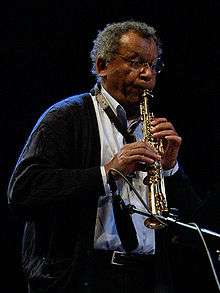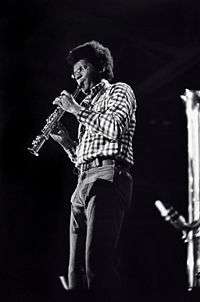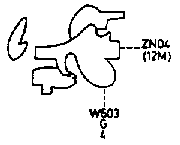Anthony Braxton
| Anthony Braxton | |
|---|---|
 | |
| Background information | |
| Born |
June 4, 1945 Chicago, Illinois, U.S. |
| Genres | Avant-garde jazz, free jazz |
| Occupation(s) | Musician, composer, educator |
| Instruments | Saxophones, clarinets, flute, piano |
| Years active | 1968–present |
| Labels | Delmark, Arista, Hathut, Black Saint, Music & Arts, Antilles, Leo, CIMP |
| Associated acts | AACM, Creative Construction Company, Circle, Dave Holland, George Lewis, Kenny Wheeler, Marilyn Crispell, Mark Dresser, Gerry Hemingway |
| Website |
tricentricfoundation |
Anthony Braxton (born June 4, 1945) is an American composer and multi-instrumentalist who is known in the genre of free jazz.[1]
Since the 1960s, he has released more than 100 albums. He plays many types of saxophone (soprano, alto, tenor, baritone, bass, contrabass, sopranino, C-melody, mezzo-soprano) and clarinet (E-flat, B-flat, contrabass), in addition to flute, alto flute, and piano.
Braxton studied philosophy at Roosevelt University. He taught at Mills College in the 1980s, and was Professor of Music at Wesleyan University from the 1990s until his retirement at the end of 2013. He taught music composition and music history, with a concentration on the avant-garde, as well as leading ensembles in performances of his compositions. In 1994, he was given a genius grant by the MacArthur Foundation. In 2013, he was named a 2014 National Endowment for the Arts Jazz Master.[2]
Life

Early in his career, Braxton led a trio with violinist Leroy Jenkins and trumpeter Wadada Leo Smith and was involved with the Association for the Advancement of Creative Musicians founded in Chicago.
In 1969, Braxton recorded the double LP For Alto. There had previously been occasional unaccompanied saxophone recordings (notably Coleman Hawkins' "Picasso"), but For Alto was the first full-length album for unaccompanied saxophone. The album's tracks were dedicated to Cecil Taylor and John Cage, among others. The album influenced other artists like Steve Lacy (soprano sax) and George Lewis (trombone), who would go on to record their own solo albums.
In 1970 Braxton joined pianist Chick Corea's trio with Dave Holland (double bass) and Barry Altschul (drums) to form the short-lived avant garde quartet Circle. He toured in France, and some concerts were recorded, such as the show in Châtellerault on March 11, 1972.[3] After Corea broke up Circle to form the fusion band Return to Forever, Holland and Altschul remained with Braxton for much of the 1970s as part of a quartet, playing with Kenny Wheeler, George Lewis, and Ray Anderson. The core trio plus saxophonist Sam Rivers recorded Holland's Conference of the Birds. In the 1970s Braxton recorded duets with Lewis and Richard Teitelbaum.
In 1975, Muse released his album Muhal with Creative Construction Company, a group consisting of Richard Davis (bass), Steve McCall (drums), Muhal Richard Abrams (piano, cello), Wadada Leo Smith (trumpet), and Leroy Jenkins (violin).
Creative Orchestra Music 1976 was inspired by jazz and marching band traditions. His regular group in the 1980s and early 1990s was a quartet with Marilyn Crispell (piano), Mark Dresser (double bass) and Gerry Hemingway (drums).[4]
In 1981 he performed at the Woodstock Jazz Festival to celebrate the tenth anniversary of the Creative Music Studio. In 1994, he was granted a MacArthur Fellowship. From 1995 to 2006, he concentrated what he called Ghost Trance Music, which introduced a pulse to his music and allowed the simultaneous performance of any piece by the performers. Many of the earliest Ghost Trance recordings were released on his Braxton House label. His final Ghost Trance compositions were performed with a "12+1tet" at Iridium club in New York City in 2006. The four-night residency was recorded and released in 2007 by Firehouse 12.
During the 1990s and early 2000s, Braxton created a large body of jazz standard recordings, often featuring him as a pianist rather than saxophonist. He had frequently performed such material in the 1970s and 1980s but only recorded it occasionally. He released multidisc sets, including two quadruple-CD sets for Leo that were recorded on tour in 2003. He worked with several groups, one where bassist Mario Pavone was credited as a co-leader with Thomas Chapin on saxophone and Dave Douglas on trumpet.
His compositions the Falling River Musics were documented on 2+2 Compositions (482 Music, 2005). In 2005, he was a guest performer with the noise group Wolf Eyes at the FIMAV Festival.[5] Black Vomit, a recording of the concert, was described by critic François Couture as sympathetic and effective collaboration: "something really clicked between these artists, and it was all in good fun."[6]
Music

At AllMusic, Chris Kelsey wrote that Braxton's approach to music is experimental and theoretical and shares characteristics with 20th Century classical music and composers such as John Cage and Karlheinz Stockhausen. Trumpeter Wynton Marsalis said Braxton's music isn't jazz. Kelsey called it "art music".[1] Braxton called it "creative music". He has said that he is not a jazz musician. But he has also said, "even though I have been saying I'm not a jazz musician for the last 25 years; in the final analysis, an African-American with a saxophone? Ahh, he's jazz!"[7]
Braxton has composed works for large-scale orchestras, including two opera cycles. He has written several volumes to explain his theories and pieces, such as the three-volume Triaxium Writings and the five-volume Composition Notes, both published by Frog Peak Music. He is notorious for naming his pieces as diagram and with cryptic numbers and letters. Sometimes these diagrams have an obvious relation to the music. On the album For Trio the title indicates the physical positions of the performers. The titles can themselves be musical notation indicating to the performer how a piece is played. Sometimes the letters are identifiable as the initials of Braxton's friends and musical colleagues. But in many cases the titles remain inscrutable. By the mid-to-late 1980s, Braxton's titles began to incorporate drawings and illustrations, such as in the title of his four-act opera cycle, Trillium R. Others began to include lifelike images of inanimate objects, namely train cars. The latter was most notably seen after the advent of his Ghost Trance Music system. Braxton settled on a system of opus-numbers to make referring to these pieces simpler, and earlier pieces have had opus-numbers retroactively added to them.
In the twenty-first century, he performs with ensembles of varying sizes and has written well over 350 compositions. After the Ghost Trance Music compositions, he became interested in three other music systems: The Diamond Curtain Wall Trio, in which Braxton implements the aid of the computer audio programming language SuperCollider;[8] Falling River Musics; and Echo Echo Mirror House Music. Braxton wrote Echo in 2007 and performed it in 2009 at Wesleyan University where he was a teacher. During the performance every musician in an ensemble of six to twenty people held an iPod that contained Braxton's discography. All of them hit play on their iPods as the performance began to broadcast old works into the live performance.[9][10]
Discography
References
- 1 2 Kelsey, Chris. "Anthony Braxton". AllMusic. Retrieved 18 August 2014.
- ↑ Olivia Drake, Braxton Receives the Nation's Highest Honor in Jazz, July 1, 2013, Wesleyan University online newsletter/blog
- ↑ Thiollet, Jean-Pierre (2017). Improvisation so piano. Neva Editions. p. 220. ISBN 978-2-35055-228-6.
- ↑ Jurek, Thom. "Quartet (Santa Cruz) 1993". AllMusic. Retrieved 21 September 2018.
- ↑ Cain, Nick (2009). "Noise". In Young, Rob. The Wire Primers: A Guide to Modern Music. London: Verso. p. 34.
- ↑ Couture, Francois. "Black Vomit". AllMusic. Retrieved 21 September 2018.
- ↑ Gagne, Cole. Soundpieces 2: Interviews with American composers. Scarecrow Press. p. 36. ISBN 9780810827103.
- ↑ Ratliff, Ben (December 16, 2012). "Following the Tradition of Being Untraditional: Anthony Braxton at the Kennedy Center". New York Times. Archived from the original on December 23, 2012. Retrieved December 23, 2012.
- ↑ Testa, Carl. "SA16: Echo Echo Mirror House Music". soundamerican.org. Retrieved 21 September 2018.
- ↑ Walls, Seth Colter (28 March 2016). "Anthony Braxton: 3 Compositions (EEMHM) 2011/Trillium J: The Non-Unconfessionables No. 380/Quintet (Tristano) 2014 Album Review". pitchfork.com. Retrieved 21 September 2018.
Bibliography
- Braxton, Anthony – Tri-Axium Writings Volumes 1–3 – 1985.
- Braxton, Anthony – Composition Notes A-E – 1988.
- Broomer, Stuart – Time and Anthony Braxton – Mercury Press, 2009.
- Ford, Alun – Anthony Braxton (Creative Music Continuum) – Stride, 2004.
- Heffley, Mike – The Music of Anthony Braxton – Greenwood, 1996.
- Lock, Graham – Forces in Motion: The Music and Thoughts of Anthony Braxton – Da Capo, 1989.
- Lock, Graham – Mixtery (A Festschrift For Anthony Braxton) – Stride, 1995.
- Lock, Graham – Blutopia: Visions of the Future and Revisions of the Past in the Work of Sun Ra, Duke Ellington, and Anthony Braxton – Duke University, 2000.
- Radano, Ronald Michael – New Musical Figurations (Anthony Braxton's Cultural Critique) – University of Chicago, 1994.
- Sinclair, John and Robert Levin – Introducing Anthony Braxton – Music & Politics – World, 1970
- Von der Weid, Jean-Noël - La musique du XXe siècle, Paris, Fayard/Pluriel, 2010, p. 400-402.
- Wilson, Peter Niklas – Anthony Braxton. Sein Leben. Seine Musik. Seine Schallplatten. – Oreos, 1993.
External links
| Wikimedia Commons has media related to Anthony Braxton. |
- Anthony Braxton and the Tri-Centric Foundation official website
- Research papers by Anthony Braxton
- "Introducing Anthony Braxton" by Robert Levin, 1970
- Interview of Braxton by Ted Panken for WKCR, 1995
- Interview excerpt, "Restructuralism, Stylism, Traditionalism", from Forces in Motion: Anthony Braxton and the Meta-reality of Creative Music by Graham Lock, 1988
- "The Third Millennial Interview" by Mike Heffley, 2001 (100+ pages)
- Interview of Braxton by Ted Panken at Intakt Records, 2002
- Audio samples from 19 Solo Compositions, 1988
- Audio samples from Composition No. 186 (1996) and Composition 304 (+ 91, 151, 164) (2002)
- Comprehensive discography